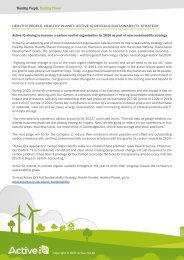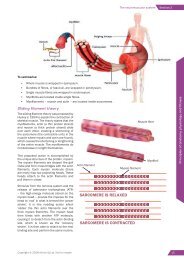Active IQ Level 2 Award in Instructing Kettlebells (sample manual)
For more information, please visit http://www.activeiq.co.uk/qualifications/level-2/active-iq-level-2-award-in-instructing-kettlebells
For more information, please visit http://www.activeiq.co.uk/qualifications/level-2/active-iq-level-2-award-in-instructing-kettlebells
Create successful ePaper yourself
Turn your PDF publications into a flip-book with our unique Google optimized e-Paper software.
this k<strong>in</strong>d of work, such as:<br />
• hypertension<br />
• osteoarthritis/rheumatoid arthritis<br />
• pregnancy<br />
• severe osteoporosis<br />
• obesity<br />
Programme design<br />
To design an effective programme we need a series of<br />
logically progressive tra<strong>in</strong><strong>in</strong>g phases. It’s important to<br />
consider the client’s lifestyle, time available, tra<strong>in</strong><strong>in</strong>g<br />
status, environment, equipment available, their likes<br />
and dislikes, and their objectives.<br />
Power<br />
Strength<br />
Hypertrophy<br />
Muscle endurance<br />
The ‘resistance tra<strong>in</strong><strong>in</strong>g progression pyramid’ shows<br />
the various types of tra<strong>in</strong><strong>in</strong>g goal that can be targeted<br />
by kettlebells.<br />
Warm-up and cool-down<br />
An appropriate warm-up for the client, environment<br />
and tra<strong>in</strong><strong>in</strong>g session must be completed to prepare<br />
them for the lifts that follow. It should consist of a<br />
pulse raiser, dynamic stretches and warm-up drills.<br />
Also a cool-down must be <strong>in</strong>cluded to return the<br />
body to a rest<strong>in</strong>g state. This should consist of a pulse<br />
lower<strong>in</strong>g activity and stretches to ma<strong>in</strong>ta<strong>in</strong> or develop<br />
flexibility.<br />
Ma<strong>in</strong> condition<strong>in</strong>g session<br />
Basic programme design rules consist of the<br />
follow<strong>in</strong>g:<br />
• complex movements early (compound<br />
exercises)<br />
• large muscle groups first<br />
• balanced muscle group selection<br />
• synergist/fixators last (isolation).<br />
Us<strong>in</strong>g the sw<strong>in</strong>g may be the first step for kettlebell<br />
beg<strong>in</strong>ners. Exist<strong>in</strong>g exercises can be <strong>in</strong>corporated<br />
<strong>in</strong>to a kettlebell rout<strong>in</strong>e.<br />
Workouts can be specifically designed to stress each<br />
of the energy systems (creat<strong>in</strong>e phosphate, lactate<br />
and aerobic) by manipulat<strong>in</strong>g programme variables.<br />
Set and reps guidel<strong>in</strong>es<br />
Some kettlebell lifts are more dynamic or explosive<br />
than others and may be suited to certa<strong>in</strong> tra<strong>in</strong><strong>in</strong>g<br />
goals, such as power. So, it’s important to th<strong>in</strong>k<br />
about exercise selection <strong>in</strong> tra<strong>in</strong><strong>in</strong>g for specific goals.<br />
The time that muscles are under tension dur<strong>in</strong>g<br />
particular lifts can also be used to determ<strong>in</strong>e the<br />
length of sets <strong>in</strong> order to conform to various tra<strong>in</strong><strong>in</strong>g<br />
goals.<br />
Tra<strong>in</strong><strong>in</strong>g goal Strength Hypertrophy Endurance<br />
Intensity High Moderate Low<br />
Load as % of 1 RM >85% 67-85%

















